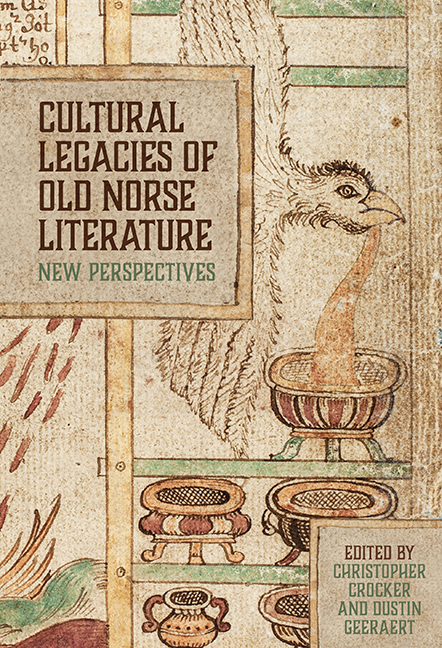Book contents
- Frontmatter
- Contents
- List of Illustrations
- List of Contributors
- Foreword: Old Norse and the Porous Boundaries of Medievalism
- Acknowledgements
- Note on the Text
- Introduction
- 1 Dr Jekyll and Mr Hyde in Medieval Iceland: Saga Realism and the Sworn Brothers
- 2 The Malleability of the Past: Íslendingabók as Narrative History
- 3 Women’s Work and Material Culture in Medieval Iceland: Gender, Narrative, and Cloth Production
- 4 Vafþrúðnismál, from Parchment to Print: Stability and Change in the Transmission of Eddic Poetry
- 5 The Odinic Motif: The Wanderer in the Mist
- 6 What has Darwin to do with Óðinn? Shapeshifting, God, and Nature in the ‘Great Story of the North’
- 7 Madness, Mythology, and Mitteleuropa: Günter Grass’s Transformation of Old Norse Myth in The Tin Drum
- 8 Once More, with Fiction: Transforming Myth in Gerður Kristný’s Blóðhófnir and the Eddic Poem Skírnismál
- Afterword: Ethnographic Medievalisms
- Bibliography
- Index
3 - Women’s Work and Material Culture in Medieval Iceland: Gender, Narrative, and Cloth Production
Published online by Cambridge University Press: 08 October 2022
- Frontmatter
- Contents
- List of Illustrations
- List of Contributors
- Foreword: Old Norse and the Porous Boundaries of Medievalism
- Acknowledgements
- Note on the Text
- Introduction
- 1 Dr Jekyll and Mr Hyde in Medieval Iceland: Saga Realism and the Sworn Brothers
- 2 The Malleability of the Past: Íslendingabók as Narrative History
- 3 Women’s Work and Material Culture in Medieval Iceland: Gender, Narrative, and Cloth Production
- 4 Vafþrúðnismál, from Parchment to Print: Stability and Change in the Transmission of Eddic Poetry
- 5 The Odinic Motif: The Wanderer in the Mist
- 6 What has Darwin to do with Óðinn? Shapeshifting, God, and Nature in the ‘Great Story of the North’
- 7 Madness, Mythology, and Mitteleuropa: Günter Grass’s Transformation of Old Norse Myth in The Tin Drum
- 8 Once More, with Fiction: Transforming Myth in Gerður Kristný’s Blóðhófnir and the Eddic Poem Skírnismál
- Afterword: Ethnographic Medievalisms
- Bibliography
- Index
Summary
‘Fine work as always, well done’. These words of praise are given by the matron supervising a group of girls working on their needlework in the women's bower, introducing us to two of the main characters in the epic medieval fantasy television show Game of Thrones. This scene is brimming with sibling rivalry; the eager elder sister is praised for her skill in needlework and the younger sister, who is averse to being there, glowers at her older sister while making a mess of her own work. This popular television show presents Sansa Stark as a model young woman being trained in the feminine arts, an anticipated character in a series portraying a medieval-based fantasy world: the maidenly female who excels in skills of womanly virtue. In contrast, the younger sister, Arya Stark, is presented as the opposite of this ideal, as she does not feel as if she belongs in this feminine world and instead longs to participate in masculine activities such as archery and swordplay.
This is a common theme in modern fantasy works based upon medieval culture: a young girl rebelling against expectations of how a young woman should act. There is a clear expectation that Sansa is the model young woman in her proper place and, through her work in improving her needlework, she is training to run her own household and make her own beautiful clothing, while Arya is rebelling against this mould and longs to be one of the boys training outside and does not feel compelled to remain inside in her proper place. This trope reflects a familiar theme found in much scholarship on medieval women, of women kept in towers and hidden within the household while the man was active in the public sphere of work, politics, and entertainment. This idea has been drawn from a continued common image of women in Old Norse scholarship which focuses on a sharp division between women and men's lives in the Icelandic Family Sagas, the Íslendingasögur.
Limited source material and information about the lives of medieval women have led scholars to write histories that have often confined women to a restric-tive private sphere, failing to include them as main actors or keeping them on the peripheries of history.
- Type
- Chapter
- Information
- Cultural Legacies of Old Norse LiteratureNew Perspectives, pp. 46 - 67Publisher: Boydell & BrewerPrint publication year: 2022

